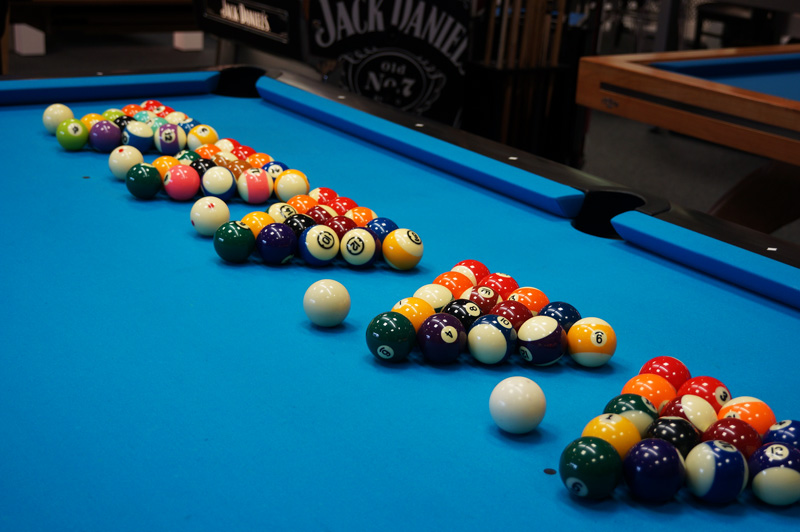Snooker is a popular international game that is most widely played in all around the world. This is also known as cue sport. It was invented in India. Yes, it is. Snooker was popular among British Army officer who is situated in India in the late 19th century.
Design of the Snooker Game
The game is made of a beautiful English Billiard Table which has a green colour cover. The magnitude of the table is twelve feet by six feet. There are four pockets on each corner of the table. Another two pockets are at the center of each long side of the table. So, six pockets are there.
Types of Balls in Snooker & their Values
There are different colours of the ball and their values.
- Red: 1
- Yellow: 2
- Green: 3
- Brown: 4
- Blue: 5
- Pink: 6
- Black: 7
The Terms for Snooker
Pot: Put any ball into any of the pockets.
Foul: playing the game in such a way that is against the rule.
Snookered: Incapable to roll the ball in a straight line.
Ball-on: To hit the desired ball by striking on the cue ball.
Snooker Rules and How to Play
World expert billiards and snooker affiliation (WPBSA) makes the standards and set rules to play snooker. Every one of the matches is played by withstanding these principles. The following are some imperative decides that a learner should know.
- A genuinely pruned ball gives the privilege to the striker to proceed at the table until the point that he neglects to authoritatively pot a ball.
- It isn’t fundamental to cause the prompt ball or a protest ball to contact the pad or drop in a pocket after the signed ball has reached a legitimate question ball. In the event that the signed ball neglected to reach a legitimate protest ball first, it will be considered as a foul.
- For whatever length of time that red balls are on the table, the striker dependably has a red as his legitimate protest ball.
- Any of the red balls pruned on an honest to goodness shot are legally pruned balls. The striker doesn’t have to call a specific red ball, pockets or points of interest of how the pot will be played.
- At the point when the striker has a red ball as his ball as a legitimate protest, he should ground the signal ball’s first contact to be with a red ball. On the off chance that he neglects to do as such, it is a foul.
- After the striker has scored a red ball at first, his next genuine question is a shading. For whatever length of time that the reds stay on the table, he should substitute his play amongst reds and hues. At the point when reds are kept on the table and shading is an objective, the striker should first assign before striking which shading ball is his protest, and besides, grounds the prompt ball’s first contact with a ball to be with the specific hued ball. In the event that the striker neglects to meet these desires, it will be a foul.
- In the event that the striker needs to pot a red ball and he pots a shading, it will be considered as a foul.
- In the event that the striker needs to pot a hued ball and he pots red ball, it will be considered as a foul.
- Bounce shots are ill-conceived in International Snooker. It is a foul if the striker intentionally causes the signed ball to hop, using any and all means.
- As the red balls stay on the table, each pruned shading is spotted before the following strike. In the event that the striker plays while a ball is wrongly denoted, the shot is taken as a foul. In the event that the striker plays two strokes after such mistake, he is free of punishment if the rival or ref don’t discourage. He can keep playing and scoring as a rule as if the spotting blunder essentially had not happened.
- At the point when no reds are left on the table, the hued balls turn into the objective of a striker in emerging numerical request (1, 2, 3, 4, 5, 6, 7). These legitimately pruned hues are not set apart after each is pruned.
Foul Rules
- 1 – Once struck, the cue ball must reach ball ON first generally, a foul is submitted.
- 2 – If your cue ball does not hit anything on the table, your adversary may take the shot or turn the table back to you.
- 3 – If you submit a foul and your adversary is snookered on all balls ON, he might be permitted to choose a free ball (any ball on the table). The free ball, for this shot just, turns into another ball ON and has similar esteem and is repotted if pruned.
- 4 – If your cue ball first hits a ball other than the ball ON, at that point the punishment is the estimation of the ball struck or 4 focuses, whichever is more prominent.
- 5 – If you pot a ball other than the ball ON, at that point you don’t score the estimation of the ball ON yet your adversary scores the estimation of the ball stashed.
- 6 – If you contact any ball on the table at any time, then the punishment is the estimation of the ball contacted or 4 focuses, whichever is more prominent.
The amusement closes when:
- A player leaves in light of the fact that there are insufficient balls on the table to compensate for the rival’s score OR he doesn’t have enough alternatives to execute a game of decent snooker to compel the rival into a foul.
- All reds and ball hues are stashed.
Also Check :










